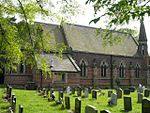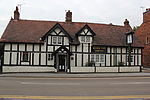Crewe Green
Borough of Cheshire EastFormer civil parishes in CheshireUse British English from July 2016Villages in Cheshire

Crewe Green is a small village and former civil parish, now in the parish of Weston and Crewe Green, in the unitary authority area of Cheshire East and the ceremonial county of Cheshire, England. The village lies 1½ miles to the east of the centre of Crewe. The parish also includes a dispersed settlement of houses and farms called Slaughter Hill, the Jacobean mansion of Crewe Hall, and the industrial estates of Crewe Hall Enterprise Park and Crewe Hall Farm. Nearby villages include Haslington and Stowford. According to the 2001 census, the parish had a population of 140, increasing to 213 at the 2011 Census.
Excerpt from the Wikipedia article Crewe Green (License: CC BY-SA 3.0, Authors, Images).Crewe Green
Narrow Lane,
Geographical coordinates (GPS) Address Nearby Places Show on map
Geographical coordinates (GPS)
| Latitude | Longitude |
|---|---|
| N 53.094743 ° | E -2.408828 ° |
Address
Narrow Lane
CW1 5UN , Weston and Crewe Green
England, United Kingdom
Open on Google Maps








